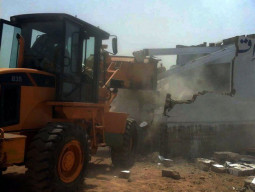
In Karachi, even though electricity theft and bill evasion occurs at quite high rates, K-Electric has created a system to exempt those areas from load-shedding where there is low theft and high bill collection. This system of incentives for positive behaviour is what has resulted in improvements in Karachi as far as load-shedding is concerned. It is a model to be replicated throughout Pakistan, not maligned as somehow part of the problem for the rest of Pakistan. We oppose the Nawaz Administration’s proposal to reduce K-Electric’s purchases of power from the NTDC, not just because it is a policy born of shortsightedness, but also because it punishes the one city that has managed to get things right. Karachi has Pakistan’s single largest concentration of industry. Its needs justify the purchase of electricity from the national grid, which is paid for by citizens of the city both, in the form of bills and the taxes that pay for the subsidies. Cutting off Karachi’s supplemental power supply would send them a bad message for good behaviour.
Published in The Express Tribune, January 30th, 2015.
Like Opinion & Editorial on Facebook, follow @ETOpEd on Twitter to receive all updates on all our daily pieces.
COMMENTS (7)
Comments are moderated and generally will be posted if they are on-topic and not abusive.
For more information, please see our Comments FAQ



1732263441-0/BeFunky-collage-(81)1732263441-0-165x106.webp)
1732263755-0/musk-(3)1732263755-0-165x106.webp)












I do know that bill collection in many large cities of Punjab are on par with of not better than Karachi; Faisalabad has a 99% recovery rate in most areas, go figure - PMLN's elitist logic is that Karachiites should suffer because Punjab's politicians (N-Leaguers) are eating from their province's electricity bills. Privatizing KESC with a dedicated foreign management was Mustaf Kamal's biggest gift to Karachiites.
Yet you continue with your statements while clearly aware that you're mentioning installed capacity and not dependable capacity.
So as per your statement, 'KE has exempted 50% of Karachi' while the rest faces 3 to 7 hours of LS, as per KE. So if its divided uniformly then 3 to 7 would go down significantly ie 1.5 hrs to 3.5 hrs a day (ie if we divided it by 2 since we are now starting LS in the exempted 50%). With 99% recovery in Lahore and minimal line losses, why does it face extensive hours of load-shed? While as per our calculation above Karachi (if all areas face equal LS), get to experience a mere 1.5 - 3.5 hrs of LS?
@Adil: at the moment about 50% of Karachi has Zero or minimal load shedding. What if tomorrow KE decides to have uniform load shedding in whole of Karachi regardless of who pays the bills and who steals electricity, than you will understand why the electricity situation is horrible in rest of Pakistan.
All of this i did write in my very first comment here, where I appreciated KE's mechanism of load shedding being linked with recovery. I also did mention in my first comment that KE has not mentioned its dependable generation capacity so i am not going to comment on it, due to a simple reason all figures and stats i quotes are with reference. I did not used any figures which are not available on the web at either KE/DISCO's own website or the regulatory body's website.
So as per the figs stated by yourself, if the recovery is higher than KElectric and line losses are lower than KElectric, then why is the electricity supply situation in the rest of Pakistan so horrible?
You should google installed capacity and dependable capacity!
@Adil: Like i said the figures I quoted are from NEPRA's State of Industry Report which is available online.
As far as i last checked NEPRA was the authority with power to Issue Licence and Determine Tariff for Generation, Transmission & Distribution of Electricity.
As for your point about Bill Recovery, the Bill is against the amount of Electricity billed Vs Bills Recovered. This does not include Transmission Losses, Distribution Losses and Electricity Theft those are included in the losses which i have also mentioned in my above post. These losses as per the last year's report for KESC or K-Electric were about 30%, where for LESCO it was 15%, IESCO less than 10%, FESCO around 10-12%, MEPCO was 32% (I am quoting from memory here so can be a little off).
As for the high amount of load shedding, please note it is being observed not just in Lahore or Punjab for that matter but also KP, Balochistan and Sindh (minus Karachi) as well.
No where in my post have I said anything about the precious 650MW which K-Electric receives from NTDC. But I did ask a question that with over 3300MW of Installed Capacity and 3000MW of peak demand why does K-Electric require additional MWs?
Dear Yousuf Malik of Lahore,
If bill recovery in Punjab is as high as 99% (which even your state minister fails to acknowledge) where is all that money going? Why does your province face ridiculously high load shed?
Reduction of 650 MW shouldn't bring your province to a stand-still!
"The power crisis in Punjab is caused not by a lack of supply, but rather it is a failure of consumers to pay and a complete disincentive for consumers to not steal electricity."
Percentage wise more consumers in Punjab pay their bills than in Karachi check the statistics you will find K Electric Line losses to be more than double of LESCO, IESCO etc only with higher/equal losses to KE in Punjab is MEPCO. Bill recovery in Punjab is well over 90% as high as 99% while KE around 85%. (all these figures are from NEPRA's state of industry report available on its website)
But the mechanism which KE has adopted in Karachi of No/Low Loadshedding in better recovery area is not followed anywhere else in Pakistan, maybe coz of simple reason all other parts of country are under Govt owned DISCOs and politicians cant seem to have the guts to call spade and a spade and tell people that your neighbor has no loadshedding coz he pays his bills while you do not. I live in an area in Lahore which has nearly 100% recovery rate rather in some months when need arises we are over billed and we pay for more electricity than we have actually consumed but do we get any benefit for being law abiding payers the answer is a BIG FAT NO!!!.
Here Honest and Crooks are treated in the same manner, in the running month of January my area faces 6-8 hours of loadshedding, I was in Karachi last week and only time lights went out in the area i was at was when 80% of country went dark due to Blackout problem.
But is K Electric being totally honest and transparent I doubt that. As per KE own website it has an installed capacity of 2341 MW plus Power Purchase Agreements with different IPPs for 1021 MW thats a total of 3362MW whereas Karachi's peak demand around what 3000MW (maybe less). As KE has no figures for dependable generation capacity on their website i cant quote those. KE instead of running its own plants (at higher cost per unit) gets power from NTDC at "Basket Rate".